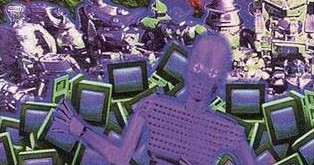
| last update 24.11.2025 11:29 | |||||
|
| What's a CCG? |
| What's Netrunner? |
| How To Start? |
| Rules Of Play |
| What's Cyberpunk? |
What is Netrunner?Netrunner is a collectible card game designed by Richard Garfield, the creator of Magic: The Gathering. It was published by Wizards of the Coast and introduced in 1996. Netrunner was lauded by critics, such as InQuest magazine, for its level of strategy and tactics, balanced game play and impressive artwork, and is regarded by many players around the world as one of the best CCGs ever published. Basic storyline and game aspectsNetrunner is based heavily on the Cyberpunk 2020 role-playing game published by R. Talsorian Games, but also draws additional flavor from the broader cyberpunk genre. Netrunner depicts cyberspace combat between a global mega-corporation (the Corp) and a hacker (the Runner). The Corp's goal is to complete their secret agendas before the Runner can hack in and spoil their secret plans for world domination. It isn't easy, though, as the Corp has strong defensive data forts protected by malevolent computer programs known as ICE (short for Intrusion Countermeasures Electronics). The Runner must use special programs of their own (called Icebreakers) to break through and steal the hidden plans - to keep the Corp from taking over completely. All this is paid for in the game by a system of resources called bits (representing currency), which are earned and spent during the course of play. An interesting feature of Netrunner is that each side has different abilities and uses completely different cards distinguished by alternate card backs. This contrasts with most other CCG's, which usually depict a "battle between peers" where each opponent draws upon the same card pool. While a player does not have to play both sides except in tournament play, it is commonly held that a firm understanding of both leads to better overall player ability. The following quote is taken from InQuest Magazine, May 1997: "Probably the best CCG on the market. Netrunner's only drawback is that it can't be played with more than two players. However, this is a small price to pay for such a marvelously crafted game of strategy and guile. Every time you play, you'll face the challenges of having to make the right tactical decision, judging your opponents poker face and executing bluffs of your own. You must consider every move your opponent makes, and he'll be putting you under the same scrutiny. The skill and concentration Netrunner requires enhances its enjoyability. Netrunner also does a great job of simulating the the feel of R. Talsorian's Cyberpunk RPG. As the Runner, you'll feel like you're putting your life on the line every time you investigate the Corp's data forts. Unlike most other games, Netrunner plays best out of a starter. Add two or three boosters and trim both your Corp and Runner Decks down to the 45-card minimum and you're ready to go. Netrunner is the benchmark of CCG's." The cardsThe Netrunner cards were initially released as a base set, followed by two expansion sets for a total of 580 different cards:
The cards were originally distributed in the following formats:
In addition, these units were also sold in boxes of 6 (Double) Starters, 36 Boosters (v1.0 and v2.1) or 24 boosters (v2.2). There are 4 different types of Runner cards...
...and 5 different types of Corp cards in the game:
As with most other CCGs, Netrunner cards have different degrees of scarcity/rarity, denoted as
Every Starter includes enough vital and common cards plus a few uncommons and rares to build a pair of balanced and well-rounded decks that can provide many interesting and challenging matches. Experienced players, however, looking for more different card effects and combinations, specialized winning strategies or just a complete set of cards may want to add boosters which include more uncommons and rares (relatively speaking). But these uncommons and rares are not needed to enjoy the game, in fact they are not even very useful in general without the support of vitals and commons. For those who like to know, the rarity distribution in Starters and Boosters is as follows:
Netrunnerís status: an out-of-print classicUnfortunately, official production, distribution and support of Netrunner by its publisher Wizards of the Coast stopped a long time ago (due to the lack of commercial success compared to other CCG products). This brings with it a lot of consequences that make it harder for players to enjoy playing this classic game:
Still, even after all these years, fans have kept playing Netrunner and still introduce new players to the game. The AfterlifeThe original Netrunner game has been reincarnated twice in the meantime, but not without change. Fantasy Flight Games (FFG) published a new version of the game in 2012 called Android: Netrunner and created a number of expansions until distribution eventually stopped in 2018. FFG used a different distribution concept they dubbed Living Card Game, in which cards were not sold in randomized booster packs anymore, but could be purchased as a complete set. Android: Netrunner can be considered a commercial success and also has a large fan base even today. However, there are also those players who did not fully enjoy the changes made in this new version and still prefer the original Netrunner. One change concerns the fictional world the game uses as a setting: Android: Netrunner is also set in a cyberpunk world, but it is a new setting created by FFG for one of its boardgames also called Android, not the world portrayed in R. Talsorianís Cyberpunk 2020 roleplaying game and, more recently, in the popular computer game Cyberpunk. |